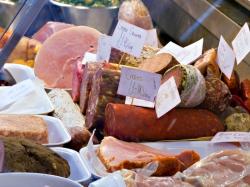Consumers Shop Delis To Recreate Restaurant Atmosphere At Home
March 22, 2011 | 4 min to read

MADISON, Wis. — The International Dairy•Deli•Bakery Association™ (IDDBA) finds cash-strapped consumers are cooking at home more often to help ease tight budgets. These shoppers are on the lookout for fresh, healthful deli foods to stretch their dollars and find a balance between convenience and value, according to the IDDBA’s What’s In Store 2011 trends report, now in its 25th year of publication.
Deli shoppers covet value
Consumers said they have modestly eased their penny-pinching habits since the height of the recession, but value is still key, making price and perceptions of price the prominent driver of purchases. Nearly two-thirds of respondents admit to monitoring their purchases more closely, and 65% are buying fewer items on impulse—down from 75% in 2009, IDDBA’s Consumers in the Deli 2010 research found. Sixty-four percent of consumers said they’re paying extra attention to advertised prices, down from 73% in 2009. Sixty-three percent say they stick to a shopping list, and 54% are using coupons more often. Thirty-nine percent of shoppers say they visit more discount stores more frequently in the current economic environment, a statistic that climbs to 50% if one household member is unemployed. Supermarket deli department sales were flat at $22 billion, according to the most recent figure available. Forty-five percent of consumers said they bought the same amount from their supermarket deli in 2010 compared to 2008. But the percentage who said they bought less has increased significantly since 2004—from 23% to 34%.
Shoppers seek-out convenient, healthful meals
Delis are becoming the bridge between dining out and dining in as time-strapped shoppers shy away from steeper restaurant prices, but still desire high-quality, easy-to-assemble meals. The deli prepared food category has grown to over 50% in the last five years, while deli meat and cheese dollar shares have gradually declined to around 24% (meats) and 19% (cheeses). Versatile rotisserie meats, like chicken, have been flying off of deli shelves. These can be eaten as they are, as well as in leftovers, sandwiches, salads, and soups. Consumers are also finding convenience and value in side dishes displayed in delis as part of grab-and-go meals that consumers can take home for dinner. Forty percent of shoppers said they eat sliced-to-order deli meats once or more a week, according to IDDBA’s Consumers in the Deli 2010, perhaps indicating that they’re packing more sandwiches for lunch to minimize food costs.
Deli salads can be healthy and convenient additions to dinner, or even eaten as snacks. Mediterranean-inspired dishes, like tabouleh, as well as Asian-inspired selections, like edamame, and Middle Eastern cuisine, like couscous, are becoming more mainstream and popular with health-conscious consumers. Delis are adding such salads to olive bars, and offering them pre-packaged in the self-service deli, as well as in the service case. The bold new flavors also happen to coincide with the healthful ambitions voiced by many deli customers.
With First Lady Michelle Obama’s Let’s Move! campaign against childhood obesity in full swing, Americans are looking to the deli for fresh, nutritionally balanced fare. Sixty-four percent of consumers report someone in their house is overweight, IDDBA research shows. More than half of respondents have someone in their household with high cholesterol or high blood pressure. Nutritious children’s dishes, smaller portioning at a value price, and sensitive ingredient foods, such as gluten-free and food allergy conscious foods, are also a hit at delis. Eighty-eight percent of those surveyed in the National Restaurant Association’s Chef Survey: What’s Hot in 2010 noted local product sourcing as a trend. Foods grown, raised or produced nearby carry a “freshness halo” that shoppers associate with nutritious items. Local produce, meats, and seafood used in deli salads or entrees are attracting customer interest, and can be cross-merchandised with products like local wine and beer beverages, further meal planning and preparation.
What's in Store 2011, our 25th anniversary edition, is a 206-page trends report, that details consumer and industry trends affecting the dairy case, cheese case, bakery, deli, and foodservice supermarket departments. Its 196 tables, developed in cooperation with leading industry firms and associations, include department sales, per capita consumption, consumer preferences, and random-weight, UPC, and private label sales data. The full report is available from IDDBA. The cost is $99 for IDDBA members and $399 for non-members, plus shipping and handling. Along with the book, readers have access to What’s in Store Online, featuring up to 53 quarterly updated, downloadable sales tables with random-weight (PLU), UPC, and system 2-coded data. In addition, the Web site offers timely white papers, trends articles, and links to all of the businesses that are referenced in the What’s in Store book. For more information, or to order, call the IDDBA Education Department at 608.310.5000 or visit the organization's Web site, http://www.iddba.org/.
# # #
Information on IDDBA’s research, education, and other industry activities is also available on its Web site, www.iddba.org, or by calling 608.310.5000. Now in its 47th year, IDDBA specializes in promoting the dairy, deli, cheese, and bakery industries. Member companies enjoy many benefits and services including the annual seminar and expo, leading-edge research, DVD and computer-based training programs, management tools, an annual trends report, and a member directory of key industry contacts.
Source: The International Dairy•Deli•Bakery Association
